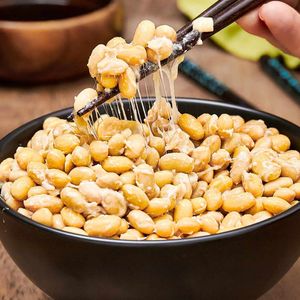Ingredients
Equipment
Method
- Thoroughly rinse dried soybeans, then soak them in abundant cold water for 12-18 hours until they have visibly doubled in size.
- Drain the soaked soybeans, rinse them again, and transfer to a pressure cooker or large pot.
- Cook soybeans: In a pressure cooker, cook for 15-20 minutes at high pressure. In a pot, simmer for 3-4 hours until very tender.
- Drain the cooked soybeans completely and allow them to cool to precisely 100-105°F (38-40°C).
- In a sterilized bowl, evenly sprinkle the natto starter spores over the warm soybeans and mix gently to distribute the starter.
- Transfer the inoculated soybeans into sterile, shallow fermentation containers, creating a layer no deeper than 1 inch (2.5 cm).
- Cover the containers loosely with a lid or plastic wrap (pierced for airflow) and place them in a fermentation chamber or incubator.
- Maintain a consistent temperature of 100-105°F (38-40°C) with high humidity, and ferment for 22-24 hours.
- After fermentation, inspect for a white film and distinct sticky threads (neba-neba); these indicate successful natto formation.
- Remove from the fermentation environment, cool completely, and then refrigerate for at least 24 hours to develop full flavor and texture before serving.
Notes
Achieving successful natto requires meticulous hygiene; sterilize all equipment to prevent unwanted bacterial growth. The cooking of soybeans is paramount—they must be very tender, almost mashable, but retain their shape. Overcooked or undercooked beans will impact the final texture and fermentation. Temperature control during fermentation (100-105°F or 38-40°C) is critical for Bacillus subtilis natto to thrive. Ensure good air circulation to prevent condensation which can lead to off-flavors. Aging the natto in the refrigerator for at least 24 hours post-fermentation significantly enhances its flavor and develops the signature stickiness. Serve traditionally with soy sauce and karashi mustard.
